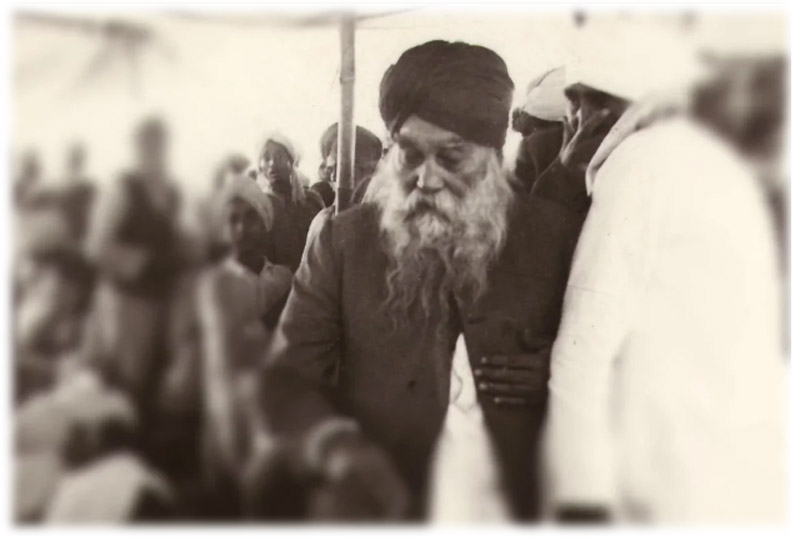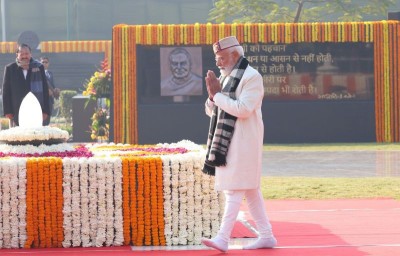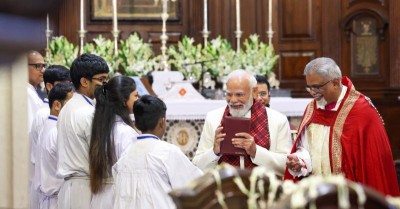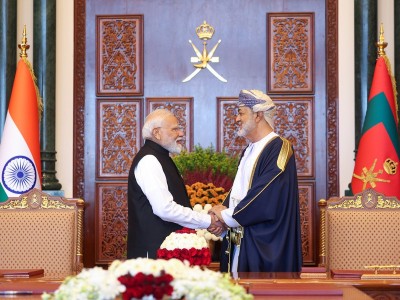 Punjab
Punjab
Pre-Independence Punjab and Sikh Politics (1920 to 1947)
Punjab, known as the fertile land of five waters, serves as the backbone of the country. With its unique character, lifestyle, and behavior, Punjabis stand apart from people in other parts of India. Inherited traits of pride and resilience define their spirit. To truly grasp the Punjabi mentality, one must delve into their glorious and prestigious history.
Punjab’s legacy dates back to ancient times. In the Treta Yuga, legends speak of Lav and Kush, who valiantly captured the horse of Ashwamedh Yag, conducted by the revered Shri Ram Chandraji. Punjab was also witness to the historic clash between Alexander the Great, led by King Porus, as they fiercely protected the Beas River and obstructed raiders from the Dara Khyber pass. These remarkable events have become an integral part of Punjab’s heritage.
Describing the essence of Punjabis in a single line, one could say, “They embrace devotion with unwavering loyalty, willing to sacrifice their lives, yet remain skeptical of others.” This resilient spirit manifested even during the British occupation, following the demise of the revered Shere Punjab Maharaja Ranjit Singh. The rebellious nature of Punjabis persisted, fueled by the incompetence of subsequent rulers. While some regard the rebellion of 1857 as India’s first war of independence, it must be acknowledged that the parties involved primarily fought to safeguard their family kingdoms rather than pursue complete liberation.
The First War for Independence against the British East India Company was led by Diwan Mool Raj, a Punjabi Hindu, in Multan, Punjab. This momentous battle took place from April 18, 1848, to January 22, 1849, showcasing a formidable resistance against the British forces. Diwan Mool Raj had previously resigned from his governorship of Multan, demonstrating his unwavering dedication to the nation. Notably, other notable figures such as Raja Sher Singh, Sardar Chatar Singh Attari Wala, and Bhai Maharaj Singh Naurangabad (who met martyrdom on July 5, 1856) also played a significant role in raising the banner of revolt. Throughout Punjab’s history, there have been few decades untouched by various struggles and uprisings.
Following the British occupation of Punjab, a wave of socio-religious reformist movements emerged. Among them were the Nirankari sect in Sikhism, led by Baba Dayal Ji (1783-1854), and the Namdhari Kuka movement, spearheaded by Bhai Balak Singh (1799-1862 AD). Another significant flame of freedom was kindled by Baba Ram Singh Ji from Village Bhaini Sahib, District Ludhiana, Punjab. Under his leadership, a non-cooperation movement, preceding Gandhi’s endeavors, fiercely challenged the British rule. Despite its religious nature, the movement aimed primarily at expelling the British and liberating the motherland. Notably, it was the first instance where 68 chickens were tied to cannons and detonated. In 1884, Baba Ram Singh tragically passed away during his exile.
A robust peasant movement has emerged, vehemently opposing the British government’s imposition of increased revenue on canal lands. This movement, driven by the mistreatment of Indians on American soil and the burning desire for liberation, culminated in the formation of a formidable ‘Treason Movement’ in 1913. President Baba Sohan Singh Bhakna, Secretary Lala Hardyal, and Kartar Singh Sarabha shared the common goal of liberating their homeland through an armed revolution to expel the British. The tragic incident of the Kama Gata Maru ship in 1914 was a poignant chapter within this movement. However, it was the appalling Jallianwala Bagh massacre in Amritsar in 1919 that sent shockwaves throughout the nation, shattering the faith of countrymen in British rule. Stricter measures such as the Roll Act and the implementation of Martial Law further exacerbated the disillusionment towards British governance.
The 18th century marked a period of struggle for the Sikh community, as they fought to preserve their existence, self-identity, and overcome political pressures while expanding their influence. During the conquest of Delhi, Kabul, Kandahar, Leh, Ladakh, and other regions, the Sikhs dedicated efforts to construct historical shrines and elevate their significance. Following the conquest of Delhi under the leadership of S: Jassa Singh Ahluwalia, the construction of Gurdwaras in Delhi, led by S: Baghel Singh, showcased the Sikhs’ devotion and love for their sacred places. Under the Sikh rule of Shere Punjab Maharaja Ranjit Singh, the administration of Gurdwaras thrived without interference. However, with the decline of Shere Punjab’s reign, the British granted influence to mahants and priests, resulting in a deterioration of Gurdwara administration. This period also witnessed the entrance of Arya Samaj into Punjab, significantly impacting the religious and social systems, further exacerbating sectarian divisions. Additionally, the British presence introduced Christianity and Western influence, prompting Hindu, Muslim, and Sikh societies to develop a heightened sense of self-protection. In 1875, Saraswati (Swami) Dayanand of Gujarat established Arya Samaj, aiming to awaken the Hindu class and disregarding non-Hindu scriptures apart from the Vedas. Dayanand brought this controversial view to Punjab in April 1877, fueling animosity and sectarianism between Hindus and Sikhs. The effects of this communal divide persist to this day. Urban Hindus in Punjab were drawn to the Arya Samaj, while Swami Dayanand’s objectionable comments about Guru Nanak Dev in his book ‘Satyaarth Prakash’ outraged the Sikh community. Despite his death, the attacks on the Gurus by Arya Samaj followers intensified. In June 1890, under the guise of purification, some Sikhs were openly murdered. The situation deteriorated to the extent that German linguist Dr. Ernest Trump boldly declared, “Sikhism is a dying religion, which will soon be buried in the bosom of history.” The actions of these Christian missionaries and Arya Samajis compelled Sikh intellectuals to abandon intellectual complacency. The Singh Sabha movement, led by Prof. Gurmukh Singh, Giani Ditt Singh, Bhai Kanh Singh Nabha, and Bhai Vir Singh, among others, provided intellectual leadership to the Sikhs. Even after a century, Bhai Kanh Singh Nabha’s influential work ‘Hum Hindu Nahi’ contrasting ‘Sikh Hindu Hai’ remains authentic.
The profound significance of Gurdwaras in the Sikh community left a lasting impression on the British colonial rulers, who discovered that these sacred spaces were more than mere temples for worship and rituals. Instead, they served as platforms for communal introspection on religious, social, and political aspects. It was within these hallowed halls that Sikhs derived their organizational structure and political influence. Recognizing the importance of Gurdwaras, the British government appointed a committee and Sarbarah to oversee their management, with a particular focus on Sri Darbar Sahib and Sri Akal Takht Sahib.
During this period, Christian missionaries actively propagated Christianity, leading some Sikh children to gravitate towards this foreign faith, causing concern among the Sikh community. The conversions of Maharaja Dalip Singh in 1853 and Kanwar Harnam Singh Kapurthala to Christianity further deepened these anxieties. Witnessing their religious system being distorted, Sikh hearts were wounded. Consequently, a sense of urgency to protect their religion and heritage took root among Sikh youth.
In response to these challenges, the Singh Sabha movement emerged in 1873, dedicated to promoting Sikhism. Within a few years, various Singh Sabhas were established across Punjab. To support these Sabhas, the Khalsa Diwan was formed as a central body. On October 30, 1902, the Khalsa Diwan of Amritsar and Lahore merged, forming a formidable entity known as the Chief Khalsa Diwan. Comprising educated leaders with influential backgrounds, the Chief Khalsa Diwan played a pivotal role in advocating for Sikh interests, while maintaining cooperation and loyalty without political conflict with the British government.
Amidst these developments, the anti-Gurmat activities of Mahants and Pujaris, who were honored by the British government, reached their peak, negatively impacting communal spaces. On October 12, 1920, under the leadership of Bhai Mehtab Singh Bir, a former Muslim who had embraced Sikhism, baptized Singhs from untouchable castes protested the ban on visiting Sri Darbar Sahib or offering prasad. Subsequently, a 9-member committee was formed after discussions with the administration, followed by the election of a 17-member committee to oversee the service of Sri Akal Takht Sahib, which had been left vacant by the priests at that time. This marked the initial steps towards the realization of the Shiromani Committee.
In light of these events, community leaders recognized the need for an elected committee to manage the Gurdwara Sahib. To this end, a Sarbat Khalsa meeting was called on November 15, 1920. Despite the government’s announcement of a 36-member committee for the management of Sri Darbar Sahib and other Gurdwaras just two days prior to the Sarbat Khalsa meeting, the Sikh community proceeded with the gathering and elected a 175-member management committee. This momentous occasion coincided with the launch of the Gurudwara reform movement, aimed at liberating all Gurdwaras from the control of Mahants.
In the midst of political upheaval, the movement found support in the establishment of the “Gurdwara Sevak Dal,” later known as the Akali Dal. This organization played a significant role in both the Gurudwara reform movement and the freedom struggle of the country.
In 1914, the movement for Gurdwara awareness took root with the front advocating the reconstruction of Gurdwara Rakab Ganj’s demolished wall. However, it reached its pinnacle during July-August 1920, compelling the British government to yield to Sikh demands for the wall’s reconstruction. Simultaneously, on September 27, 1920, the Sikh Sangat reclaimed Gurdwara Chumala Sahib, Patishahi Sixth, Lahore, effectively launching the Gurdwara reform movement. Furthermore, Gurdwara Baba di Ber in Sial Kot was successfully acquired. On November 19, 1920, Gurdwara Panja Sahib was liberated through the unwavering leadership of S. Kartar Singh Jhabbar.
A significant turning point occurred during negotiations between Jathe (group) and Mahants (temple custodians) at Gurdwara Taran Taran Sahib on January 25, 1921. Tragically, the Mahants attacked the Jathe, resulting in the martyrdom of Bhai Hazara Singh Aladin Pur and Bhai Hukum Singh Wajau Kot. The martyrdoms of the Shaheed Jatha, led by Lachhman Singh Dharowali, to free Gurdwara Janm Asthan Nankana Sahib garnered global attention. On February 20, 1920, Mahant Narainu Das, the corrupt custodian of Nankana Sahib, orchestrated a massacre of the Shaheed Jatha from Dharowali, leaving 168 martyrs. The victims outside the Singh Gurdwara were also brutally slain. Following these events, on February 21, 1921, Commissioner Lahore handed over the keys of Gurdwara Sri Nankana Sahib to Jathedar Kartar Singh Jhabbar, marking a significant victory. Similarly, on January 19, 1922, the DC of Amritsar yielded the keys of the Toshe Khane at Sri Darbar Sahib Amritsar to Baba Kharak Singh, President of the Shiromani Committee. The triumph of this movement led Mahatma Gandhi to declare it as “India’s first battle for independence.”
In the pursuit of peaceful struggle, no other nation shines brighter than the Sikh community. Their unwavering commitment to nonviolent resistance was demonstrated during Guru Ka Bagh da Morche, where the Singhs became a symbol of resilience. Despite facing brutal treatment from the police, who ruthlessly beat them with sticks, the world stood witness to their persecution as reports flooded newspapers globally. An inquiry committee report revealed that a staggering 1656 Sikhs were injured, and the martyrs Bhagat Singh and Tara Singh sacrificed their lives for the cause. In the end, the Sikhs emerged triumphant in their battle.
Another historic event, Saka Panja Sahib, unfolded on October 30, 1922, when Hasan Abdal Panja Sahib halted a train and laid down on the Singh railway line to provide langar to the prisoners. The train came to a halt after passing a group of devotees. Unfortunately, Bhai Pratap Singh and Bhai Karam Singh met a tragic end as martyrs, and numerous others suffered severe injuries.
Furthermore, when the Shiromani Committee took a firm stand in support of Maharaja Ripudaman Singh of Nabha, who had backed the Akali Singhs, a violent confrontation ensued. On February 21, as the Jatha departed from Sri Akal Takht Sahib and reached Jaito, the government ordered the army to open fire, resulting in the deaths of dozens of brave Singhs and leaving many injured. The police continued their relentless harassment of others involved. Not only did Singhs from Punjab join this movement, but also those from Bengal. Despite emerging victorious, the question of reinstating the Maharaja remained unanswered. The front witnessed the sacrifice of hundreds of martyrs and left thousands with life-altering injuries. Many lost their properties and were banished from the princely states. Moreover, this movement led to the acquisition of several Gurdwaras for the community.
In a decisive move aimed at resolving the ongoing struggle for panthic control over Gurdwaras, the government has made a landmark decision. The Gurdwara Act, introduced on 21 January 1925, grants elected representatives the responsibility of managing the Gurdwaras in Punjab. This crucial development comes after years of tireless efforts by the Sikh community.
During the heated debate on July 9, in the Punjab Assembly, the Hindu members voiced their support for the Mahants, opposing the bill. They also demanded representation for the Hindu community. Responding to these concerns, the Gurdwara Act was amended on 28 July, with the approval of the Governor of Punjab. The Act officially came into effect on 1 November 1925, empowering elected Sikh representatives to take charge of Gurdwara management.
Initially known as the “Central Board,” the governing body later evolved into the Shiromani Gurdwara Parbandhak Committee (SGPC). While the establishment of the SGPC has been considered a boon for the Sikh panth, it has also faced criticism. The implementation of the Committee Act led to the diminishing influence of Sikh bodies like the Sarbat Khalsa. Despite the absence of provisions for Jathedars in the Gurdwara Act, the election process for Jathedars fell under the purview of the Shiromani Committee. Consequently, independent Jathedars became susceptible to political control through the Committee, which raised concerns about the intrusion of politics into the sacred gurdwara system.
The relationship between the Akali Dal and the Shiromani Committee brought mutual strength, but also exposed each other’s weaknesses. The advent of “politics” within the gurdwara system gave rise to numerous challenges and ambiguities that persist to this day.
According to the 1921 census, the population composition in Punjab was reported as follows: Sikhs accounted for 12 percent, Hindus 35 percent, and Muslims slightly over 50 percent. However, despite the increase in the Muslim population, the voting power of Sikhs remained at 24 percent, while Hindus had 40 percent, due to property and education-based voting rights. Consequently, Muslims persistently demanded separate reserved constituencies. In an attempt to find common ground, a compromise was reached between the Congress and the Muslim League through the Lucknow Pact of 1916. This resulted in the agreement for separate constituencies for Muslims at both the central and provincial levels. Regrettably, the Sikh community was completely overlooked in this agreement, effectively paving the way for Muslim constitutional rule in Punjab. It is worth noting that Britain acknowledged the Sikhs’ claims for separate nationhood, as reflected in the Montague Report of 1918, which recognized the minority status of Sikhs and their significant contributions in the military and other areas. In 1929, during the Lahore session of the Congress Party, the resolution for Puran Swaraj (complete independence) was passed. The Simon Commission faced widespread opposition across the country. During the Simon Commission of 1930, Muslims argued that without the freedom to choose their representatives, their interests could not be protected due to their economic and educational disadvantages. Meanwhile, the Sikhs, led by the Chief Khalsa Diwan, advocated against granting reservations to any specific group and instead proposed a Sikh “United Indian Nation.” Simultaneously, the Sikhs demanded representation in all spheres and one-third of the nominations. Their ultimate aim was to challenge the constitutional majority held by Muslims. However, Britain rejected this demand. Furthermore, Bhimrao Ambedkar demanded reservation for the untouchables. Two round table conferences were convened in London to discuss the Simon Commission report. Consequently, the government approved the “Communal Award” in 1932, reserving 51 percent of seats for Muslims, leaving the Sikhs disappointed. In 1935, the British Parliament abolished dual governance in the provinces by enacting the Government of India Act. The Legislative Council, comprising 175 seats, allotted 48 percent to Muslims, 24 percent to Hindus, and 18 percent to Sikhs. During 1936 and 1937, conflicts arose between Congress President Jawaharlal Nehru and Muslim League leader Muhammad Ali Jinnah. While Nehru stated that the two parties in India were the British government and the Congress, Jinnah identified Muslims as a separate party. Over time, the Muslim League gained momentum. In March 1940, during the Lahore session of the Muslim League, Jinnah raised the demand for a separate state (Pakistan) for Muslims, further fueling tensions. Subsequently, the Sikh community also demanded Khalistan. The overall atmosphere grew increasingly tense.
In December 1940, a conference was held opposing Pakistan, with Master Tara Singh firmly rejecting its demand as “mischievous and poisonous.” He declared that the creation of Pakistan would not be allowed, even if it meant sacrificing lives. Similarly, in March 1941, Zinah emphasized the significance of Pakistan for Muslims, describing it as a matter of life and death.
During this period, the Sikh community expressed readiness to support Congress against Pakistan. However, a hurdle emerged as Congress decided not to recruit for World War II, while Sikh leaders believed Sikhs had a vital role to play in the army. In early 1941, the Akali Dal announced its support for the British in the war.
March 1942 marked the visit of Cripps to India, where he proposed that India’s independence could be considered once the war concluded. He suggested the immediate formation of a national government if political leaders agreed. This brought happiness to Congress, but it also fueled the League’s aspirations for independence and the formation of Pakistan after the war, causing anxiety among Hindus and Sikhs in Punjab. Consequently, plans to arm were accelerated.
In November 1942, Jinnah mentioned the necessity for dealings between Sikhs and Muslims in Punjab. However, he also expressed that Muslims would protect themselves with force if needed, raising doubts about Muslim-Sikh unity. When confronted with the Sikandar-Zinah Pact, which prohibited political agitation by the League in Punjab, Jinnah insisted that Pakistan would be created in Punjab, not Bombay.
Master Tara Singh warned that forcing Pakistan upon Sikhs would greatly undermine the morale of Sikh soldiers in the army. In an attempt to reach an agreement between the Muslim League and Congress, Gandhi proposed holding a referendum across the country to separate Muslim-majority areas after independence.
The failure of Gal Baat due to the absence of autonomy made Jinnah realize its significance. On June 14, 1945, Viceroy Wavell discussed the release of Congress leaders and the possibility of a National Government at Shimla. The British aimed to create a pro-British Pakistan, leading to Unionist movement Muslim leaders joining the League and expanding its influence in rural areas.
The provincial elections of 1945-46 fueled factionalism within Congress and the League, but the latter failed to form a government. With support from Congress and Akalis, Khizr became the Prime Minister of Punjab.
Jinnah emphasized that the League would not tolerate a Prime Minister in majority Muslim Punjab who relied on support from Hindus and Sikhs. In an attempt to appease the Sikhs, he proposed the formation of a separate Sikh state where they constituted the majority. However, the Sikh leadership disregarded this offer.
On March 15, 1946, Prime Minister Attlee announced Britain’s decision to leave India. Subsequently, three British ministers arrived in Pakistan for negotiations. Witnessing the situation, the Sikhs reluctantly accepted the partition of Punjab. Jinnah offered autonomy to Sikhs in Pakistan, but due to mutual distrust, the talks yielded no results. The Sikh leadership stood with Congress and India against the creation of Pakistan.
The Sikhs played a significant role in integrating East Punjab into India during independence. They bore heavy losses of life and property during the partition, with 179 renowned historical Gurdwaras remaining in Pakistan. These events have profoundly influenced post-independence Punjab and Sikh politics, which will be further explored in subsequent discussions.
The opinions expressed in this article are those of the author. They do not purport to reflect the opinions or views of Khalsa Vox or its members.
(Image and Text credit: Khalsavox.com)
Support Our Journalism
We cannot do without you.. your contribution supports unbiased journalism
IBNS is not driven by any ism- not wokeism, not racism, not skewed secularism, not hyper right-wing or left liberal ideals, nor by any hardline religious beliefs or hyper nationalism. We want to serve you good old objective news, as they are. We do not judge or preach. We let people decide for themselves. We only try to present factual and well-sourced news.







